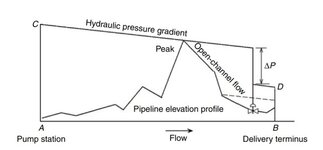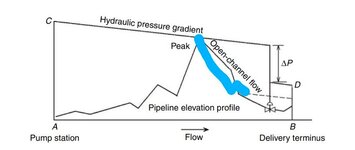Navigation
Install the app
How to install the app on iOS
Follow along with the video below to see how to install our site as a web app on your home screen.
Note: This feature may not be available in some browsers.
More options
Style variation
-
Congratulations LittleInch on being selected by the Eng-Tips community for having the most helpful posts in the forums last week. Way to Go!
You are using an out of date browser. It may not display this or other websites correctly.
You should upgrade or use an alternative browser.
You should upgrade or use an alternative browser.
hydraulic grade line 2
- Thread starter Thuba
- Start date
LittleInch
Petroleum
Incorrect.
Pressure loss in a valve can be very high.
What this is showing is that to remain in tight flow regime, you need to hold a high back pressure.
Is not clear why there are two control valves, one whet shown and one at the terminal. Normally you would only have one control valve at the terminal.
Pressure loss in a valve can be very high.
What this is showing is that to remain in tight flow regime, you need to hold a high back pressure.
Is not clear why there are two control valves, one whet shown and one at the terminal. Normally you would only have one control valve at the terminal.
-
1
- #4
This is my interpretation.
Pipe flows full upstream of the peak. Pump has just enough discharge head to get the flow over the peak. Hydraulic pressure curve is sum of pump discharge pressure plus static head plus velocity head minus friction losses. Once flow reaches peak all head is in static pressure head plus velocity head with pressure head zero.
Flow on right side of peak static head is converted to velocity head and any loss in hydraulic head is due to friction losses. I interpret the dashed line as that above the dashed line there is open channel flow and below the dashed line there is full pipe flow. The valve keeps enough back pressure to develop full pipe flow upstream of the valve where the dashed line intersects the pipe. Note that the valve is a control valve and this is what it is controlling.
As LI indicated the pressure drop is across the valve and is the delta P shown in the diagram and equal to the pressure drop induced by the valve to get full flow upstream. Downstream of the valve the head is the sum of pressure head plus static head plus velocity head. Static and pressure head is converted to friction and velocity head is lost when the fluid hits the ground so at "D" total head is zero.
Pipe flows full upstream of the peak. Pump has just enough discharge head to get the flow over the peak. Hydraulic pressure curve is sum of pump discharge pressure plus static head plus velocity head minus friction losses. Once flow reaches peak all head is in static pressure head plus velocity head with pressure head zero.
Flow on right side of peak static head is converted to velocity head and any loss in hydraulic head is due to friction losses. I interpret the dashed line as that above the dashed line there is open channel flow and below the dashed line there is full pipe flow. The valve keeps enough back pressure to develop full pipe flow upstream of the valve where the dashed line intersects the pipe. Note that the valve is a control valve and this is what it is controlling.
As LI indicated the pressure drop is across the valve and is the delta P shown in the diagram and equal to the pressure drop induced by the valve to get full flow upstream. Downstream of the valve the head is the sum of pressure head plus static head plus velocity head. Static and pressure head is converted to friction and velocity head is lost when the fluid hits the ground so at "D" total head is zero.
- Thread starter
- #5
Ok noted, thank youIncorrect.
Pressure loss in a valve can be very high.
What this is showing is that to remain in tight flow regime, you need to hold a high back pressure.
Is not clear why there are two control valves, one whet shown and one at the terminal. Normally you would only have one control valve at the terminal.
- Thread starter
- #6
its a conduit/pipe with slack flow.The valve at the end of the open channel flow segment also makes no sense. If you have open channel flow, a slide gate is used, not a valve. Valves are used on closed conduits.
- Thread starter
- #7
Thank you for available information. Does is it mean the dashed lined is hydraulic pressure curve for open channel flow?This is my interpretation.
Pipe flows full upstream of the peak. Pump has just enough discharge head to get the flow over the peak. Hydraulic pressure curve is sum of pump discharge pressure plus static head plus velocity head minus friction losses. Once flow reaches peak all head is in static pressure head plus velocity head with pressure head zero.
Flow on right side of peak static head is converted to velocity head and any loss in hydraulic head is due to friction losses. I interpret the dashed line as that above the dashed line there is open channel flow and below the dashed line there is full pipe flow. The valve keeps enough back pressure to develop full pipe flow upstream of the valve where the dashed line intersects the pipe. Note that the valve is a control valve and this is what it is controlling.
As LI indicated the pressure drop is across the valve and is the delta P shown in the diagram and equal to the pressure drop induced by the valve to get full flow upstream. Downstream of the valve the head is the sum of pressure head plus static head plus velocity head. Static and pressure head is converted to friction and velocity head is lost when the fluid hits the ground so at "D" total head is zero.
that is not a standard gate valve symbol and looks similar to a PRV valve symbol i have seen before (backed up by the significant HGL drop)

you need the high initial head to pump over the peak, but that could mean you get excessive pressure at discharge, hence the PRV. With that head loss i would think you would only get slack flow without the valve - the valve will back up the flow and remove the slack flow IMO

you need the high initial head to pump over the peak, but that could mean you get excessive pressure at discharge, hence the PRV. With that head loss i would think you would only get slack flow without the valve - the valve will back up the flow and remove the slack flow IMO
-
1
- #9
I don't think so. I think it just represents where full pipe flow exists. Above the dashed line is open channel flow just as it indicates in the diagram. I believe the pressure curve is the thick line as shown. Up to the valve the energy of the fluid is still the entire static head at the peak plus velocity head minus some head loss due to friction so hydraulic curve is still relatively high. With slack flow all static head at the peak is converted to velocity head as it falls down the pipe with losses due to friction making the hydraulic line drop slightly.Thank you for available information. Does is it mean the dashed lined is hydraulic pressure curve for open channel flow?
On the upstream side of the valve you still have most of the energy available as you had at the peak just minus friction losses. Then right at the valve there is high delta P across the valve = vertical drop of thick dark line. Then thick dark horizontal line from there is continuation of hydraulic line. I think the vertical dark line between the top of the valve to where the thick dark line goes horizontal at the valve is an error and should be erased.
"D" is where the hydraulic grade is at the end of pipe which is due to velocity plus static height above the datum point (which is horizontal line at very bottom, then goes to zero at "B" when fluid hits the ground.
Last edited:
It essentially shows the water surface elevation. It's open to atmosphere, hence there will be no pressure head.Thank you for available information. Does is it mean the dashed lined is hydraulic pressure curve for open channel flow?
The bold line HGL is surely for the conduit flow, i.e through the pipeline.
- Thread starter
- #11
I don't think so. I think it just represents where full pipe flow exists. Above the dashed line is open channel flow just as it indicates in the diagram. I believe the pressure curve is the thick line as shown. Up to the valve the energy of the fluid is still the entire static head at the peak plus velocity head minus some head loss due to friction so hydraulic curve is still relatively high. With slack flow all static head at the peak is converted to velocity head as it falls down the pipe with losses due to friction making the hydraulic line drop slightly.
On the upstream side of the valve you still have most of the energy available as you had at the peak just minus friction losses. Then right at the valve there is high delta P across the valve = vertical drop of thick dark line. Then thick dark horizontal line from there is continuation of hydraulic line. I think the vertical dark line between the top of the valve to where the thick dark line goes horizontal at the valve is an error and should be erased.
"D" is where the hydraulic grade is at the end of pipe which is due to velocity plus static height above the datum point (which is horizontal line at very bottom, then goes to zero at "B" when fluid hits the l
thank you sirI don't think so. I think it just represents where full pipe flow exists. Above the dashed line is open channel flow just as it indicates in the diagram. I believe the pressure curve is the thick line as shown. Up to the valve the energy of the fluid is still the entire static head at the peak plus velocity head minus some head loss due to friction so hydraulic curve is still relatively high. With slack flow all static head at the peak is converted to velocity head as it falls down the pipe with losses due to friction making the hydraulic line drop slightly.
On the upstream side of the valve you still have most of the energy available as you had at the peak just minus friction losses. Then right at the valve there is high delta P across the valve = vertical drop of thick dark line. Then thick dark horizontal line from there is continuation of hydraulic line. I think the vertical dark line between the top of the valve to where the thick dark line goes horizontal at the valve is an error and should be erased.
"D" is where the hydraulic grade is at the end of pipe which is due to velocity plus static height above the datum point (which is horizontal line at very bottom, then goes to zero at "B" when fluid hits the ground.
LittleInch
Petroleum
Hang on.
This looks like some AI generated crap when you look at the file name (...MS copilot.jpg) and makes no sense without knowing what it is trying to show and what those letters mean, if anything.
If this is slack flow, what is the line that keeps going through the peak?
The dashed line makes no sense.
This diagram needs a better explanation as to whether it came from and what it is trying to show.
This looks like some AI generated crap when you look at the file name (...MS copilot.jpg) and makes no sense without knowing what it is trying to show and what those letters mean, if anything.
If this is slack flow, what is the line that keeps going through the peak?
The dashed line makes no sense.
This diagram needs a better explanation as to whether it came from and what it is trying to show.
- Thread starter
- #13
true, the dashed line confused me too. lts a piping handbook, see attachedHang on.
This looks like some AI generated crap when you look at the file name (...MS copilot.jpg) and makes no sense without knowing what it is trying to show and what those letters mean, if anything.
If this is slack flow, what is the line that keeps going through the peak?
The dashed line makes no sense.
This diagram needs a better explanation as to whether it came from and what it is trying to show.
Attachments
LittleInch
Petroleum
That's a terrible explanation and example.
Too many ifs and if the aim was to show slack line flow then they needed to remove the
Delta P stuff as its just confusing. A high pressure drop usually needs some high jntegrity valves at the entry to the terminal to reduce pressure within the terminal.
What though is your problem with it?
And next time post the full information not just a little bit.
Too many ifs and if the aim was to show slack line flow then they needed to remove the
Delta P stuff as its just confusing. A high pressure drop usually needs some high jntegrity valves at the entry to the terminal to reduce pressure within the terminal.
What though is your problem with it?
And next time post the full information not just a little bit.
- Thread starter
- #15
My problem was the dotted line, but some have answered me on that.That's a terrible explanation and example.
Too many ifs and if the aim was to show slack line flow then they needed to remove the
Delta P stuff as its just confusing. A high pressure drop usually needs some high jntegrity valves at the entry to the terminal to reduce pressure within the terminal.
What though is your problem with it?
And next time post the full information not just a little bit.
- Thread starter
- #16
Again my confusion is, l know to prevent slack flow, the hydraulic grade line should clear the pipe profile incase of packed flow. But for slack flow, how would l know if there is enough back pressure to prevent slack flow by just looking at the hydraulic grade line graph?
LittleInch
Petroleum
Because the hydraulic grade line would be straight, with no dips in it to prevent slack flow.
High points relatively close ( say in the last 20% of the length) or very high peaks always cause this issue.
Your question though makes no sense. "For slack flow.... prevent slack flow..." in the same sentence.
What do you want to know? how to prevent slack flow ( always a good plan in my opinion) or what happens when you have it?
High points relatively close ( say in the last 20% of the length) or very high peaks always cause this issue.
Your question though makes no sense. "For slack flow.... prevent slack flow..." in the same sentence.
What do you want to know? how to prevent slack flow ( always a good plan in my opinion) or what happens when you have it?
- Thread starter
- #18
Good day guys. l finally got around it: lf there were no valve, the hydraulic grade line would drop at the peak below the pipe line profile and join the dotted line, where the all the flow will rush and flow becomes packed again due to pipeline leveling up. But from the peak to the dotted line flow will be slack flow with the hydraulic line shown in blue.
Attachments
Similar threads
- Replies
- 19
- Views
- 6K
- Replies
- 10
- Views
- 23K
- Question
- Replies
- 3
- Views
- 2K
- Question
- Replies
- 2
- Views
- 3K




